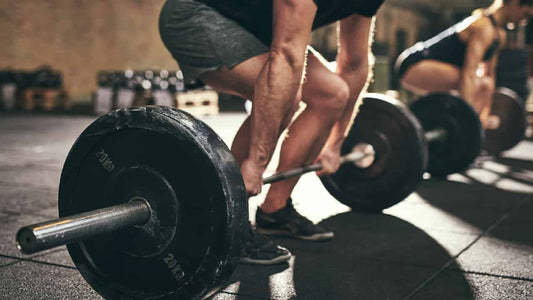Foam rolling is the one recovery technique with which most athletes have a love-hate relationship.
It’s like the John Mellencamp song goes “hurts so good, come on baby make it hurt so good,” except we’re talking about your muscles. While you’re rolling, the pain can be excruciating, but the results make all the pain worth it.
Whether you’re dealing with nagging muscle pain or trying to prevent nagging muscle pain, foam rollers are something that everyone should have in their home, athlete or not.
If you’re new to foam rolling or just trying to figure out when is the best time to do it, this article is for you. We’re covering the basics—what foam rolling is, why it’s beneficial, when is the best time to do it, and other tips for maximizing your recovery.
Why Should You Foam Roll?
There’s no denying that training—for strength, power, speed, endurance, etc.—is hard on the body.
If you’ve ever done a big lift, you’ve probably felt the soreness kick in a few days following. But before we can talk about why foam rolling is so great, we first need to understand what it is and what it targets.
Foam rolling is a form of soft tissue work, more formally known as myofascial release or MFR. It’s an excellent way to alleviate muscle pain and tension caused by adhesions between muscles and fascia. These myofascial adhesions are the painful ‘knots’ we find in muscles.
Fascia is a layer of tissue surrounding muscle that separates them from other organs. When trauma occurs to tissues from exercise and doesn’t heal properly, the body produces collagen to heal the damaged tissue.
Although there’s nothing inherently wrong with collagen production, the collagen fibers clump together in a way that doesn’t align with the natural structure of the muscle fiber.
Unlike soft tissue in the muscle or fascia, these collagen adhesions are ‘sticky,’ so the fascia begins to stick to other tissues and create tension. Think of fascia like cling wrap—it sticks to surrounding tissues and forms clumps unless you flatten it out.
Tight fascia interferes with proper movement patterns and causes the body to shift out of alignment, creating pressure on the muscles and joints. Over time, they become compressed, leading to poor range of motion, tightness or stiffness, and muscular imbalances and pain.
But the reason why we foam roll is to make sure these new collagen fibers lay down flat and parallel to your existing muscle tissue fibers, thereby reducing the risk of forming myofascial adhesions as you build new muscle.
Although there’s no consensus as to why foam rolling is so beneficial, research suggests several mechanisms, including 1:
- Reducing tissue adhesion
- Altering tissue stiffness
- Potentiates analgesic (pain relief) effects and muscle recovery via mediating pain-modulatory systems
- Increases blood flow
- Boosts parasympathetic circulation
- Increases inflammatory responses and associated trigger-point breakdown
- Enhances perceptions of well-being and recovery via increasing endorphin release
- Activates parasympathetic response and placebo effect
So, why foam roll?
- Ease muscle pain
- Reduce inflammation
- Increase range of motion
- Improve recovery
- Reduces risk of muscle imbalances
- Increase blood flow
- Prevent injury
Should I Foam Roll Before Or After A Workout?
Like stretching, one of the big questions with foam rolling is when to do it. Is it more beneficial before a workout, after, or both?
Foam rolling can be done before or after a workout for maximum benefit. Before training, foam rolling can help increase tissue elasticity, range of motion, and blood flow, which can improve performance during your workout and help safeguard you against injury.
Rolling before a workout is effective because muscles contain two primary receptors—muscle spindles, which contract the muscle, and the Golgi tendon organ, which relaxes the muscle.
When these receptors are in balance, it allows the muscle to work properly without getting injured. However, if you’re dealing with muscle imbalances and going about your standard warmup of just static or dynamic movements, your body will consistently compensate for these problem spots.
The deep pressure of rolling helps activate Golgi tendon organs and allows the muscles to relax, which can then be stretched—as such, rolling before you stretch and do any exercise essentially takes the pressure off your brakes.
So, the ideal system is—foam roll, static stretch, and follow up with dynamic stretches. It’s a great way to reduce the risk of injury during your workouts.
But to make the most out of your rolling session, don’t just roll back and forth—roll to find the most tender spot in the area and hold the roller for 60 seconds.
Holding at sensitive sites helps trigger that relaxation reflex in your muscles, which is the first step to a good warmup. Follow up your rolling session with stretching and dynamic exercises.
If you’re experiencing more soreness or discomfort the day after foam rolling, it could be the result of rolling for too long or too hard. If you need to, set a time to prevent over-rolling.
The Science Of Foam Rolling
There’s much debate about which is better—rolling before or after a workout—so let’s look at the studies.
A 2019 study published in Frontiers of Physiology compared the effects of foam rolling before and after exercise on sprint, jump, strength performance, flexibility, and muscle pain to determine whether a foam roller or roller massage was more effective 1. Here’s what they found:
- Rolling before exercise resulted in a slight improvement in sprint performance and flexibility and negotiable gains in jump and strength performance
- Post-workout rolling slightly mitigated exercise-induced decreases in sprint and strength performance
- Rolling post-workout reduced muscle pain perception
- Foam rollers offer greater effects on recovery of strength performance
A 2015 study published in the Journal of Athletic Training looked at foam rolling after an intense bout of exercise on DOMS and recovery by measuring pressure-pain threshold, sprint time, change-of-direction speed, power, and dynamic strength-endurance 2.
They found that foam rolling post-workout significantly improved muscle tenderness in the quads and sprint time, power, and dynamic strength-endurance.
Another study found that foam rolling can increase range of motion without interfering with muscle forces 3. Similarly, a 2014 study published in the Journal of Sport Rehabilitation found that foam rolling before static stretching can significantly change passive hip-flexion ROM 4.
Although many people foam roll post-workout, there’s some evidence suggesting that pre-workout rolling is more beneficial for performance and injury prevention. However, rolling afterward may support reduced muscle soreness (DOMS).
Three Tips To Boost Your Recovery
Get enough sleep
Exercising daily is great, but if you’re not sleeping properly, your body isn’t recovering.
For men, in particular, the release of testosterone and growth hormone—both critical for muscle growth and recovery—is released during sleep, specifically during slow-wave sleep 5.
Sleep restriction causes testosterone levels to tank, but it also interferes with your body’s ability to recover from strenuous exercise by modifying inflammatory and hormonal responses 6, 7.
Although sleep needs differ between people, ideally, you want to aim for 7-9 hours of deep, uninterrupted sleep each night.
Stay hydrated
Hydration is vital if you want to perform optimally—it’s involved in regulating blood volume, body temperature, muscle contraction, etc. And just a 2% drop in body water content can significantly impact both physical and mental performance.
Dehydration can cause reduced blood volume, blood flow to the skin, sweat rate, and increased core temperature and glycogen use rate. Changes in physiological mechanisms from dehydration lead to less blood entering the heart, decreasing cardiac output and maximal aerobic power (VO2 max) 8.
Aim to consume 2-3L of water daily, increasing the amount to compensate for increased sweat or caffeine consumption.
Supplement where needed
Chowing down on a post-workout meal of protein and carbs is a good idea if you’re looking for muscle growth and repair, but sometimes that’s not enough.
Although it’s not recommended to skip your meal in place of supplements, adding specific ones can support a faster and more efficient recovery.
Performance Lab Recover is an all-in-one anabolic muscle fuel designed to replenish glycogen stores, restore nutrients, and support growth and healing for maximum gains.
Combining KarboLyn®, Oryzatein® organic brown rice, beta-alanine, and NutriGenesis nutrients, Recover excels your recovery using patented ingredients that unlock synergy for maximum gains.
References
- Wiewelhove T, Döweling A, Schneider C, et al. A Meta-Analysis of the Effects of Foam Rolling on Performance and Recovery. Front Physiol. 2019;10:376.
- Pearcey GE, Bradbury-Squires DJ, Kawamoto JE, Drinkwater EJ, Behm DG, Button DC. Foam rolling for delayed-onset muscle soreness and recovery of dynamic performance measures. J Athl Train. 2015;50(1):5-13.
- García-Gutiérrez MT, Guillén-Rogel P, Cochrane DJ, Marín PJ. Cross transfer acute effects of foam rolling with vibration on ankle dorsiflexion range of motion. J Musculoskelet Neuronal Interact. 2018;18(2):262-267.
- Mohr AR, Long BC, Goad CL. Effect of foam rolling and static stretching on passive hip-flexion range of motion. J Sport Rehabil. 2014;23(4):296-299.
- Davidson JR, Moldofsky H, Lue FA. Growth hormone and cortisol secretion in relation to sleep and wakefulness. J Psychiatry Neurosci. 1991;16(2):96-102.
- Leproult R, Van Cauter E. Effect of 1 week of sleep restriction on testosterone levels in young healthy men. JAMA. 2011;305(21):2173-2174.
- Dáttilo M, Antunes HKM, Galbes NMN, et al. Effects of Sleep Deprivation on Acute Skeletal Muscle Recovery after Exercise. Med Sci Sports Exerc. 2020;52(2):507-514.
- Watanabe K, Stöhr EJ, Akiyama K, Watanabe S, González-Alonso J. Dehydration reduces stroke volume and cardiac output during exercise because of impaired cardiac filling and venous return, not left ventricular function. Physiol Rep. 2020;8(11):e14433.















